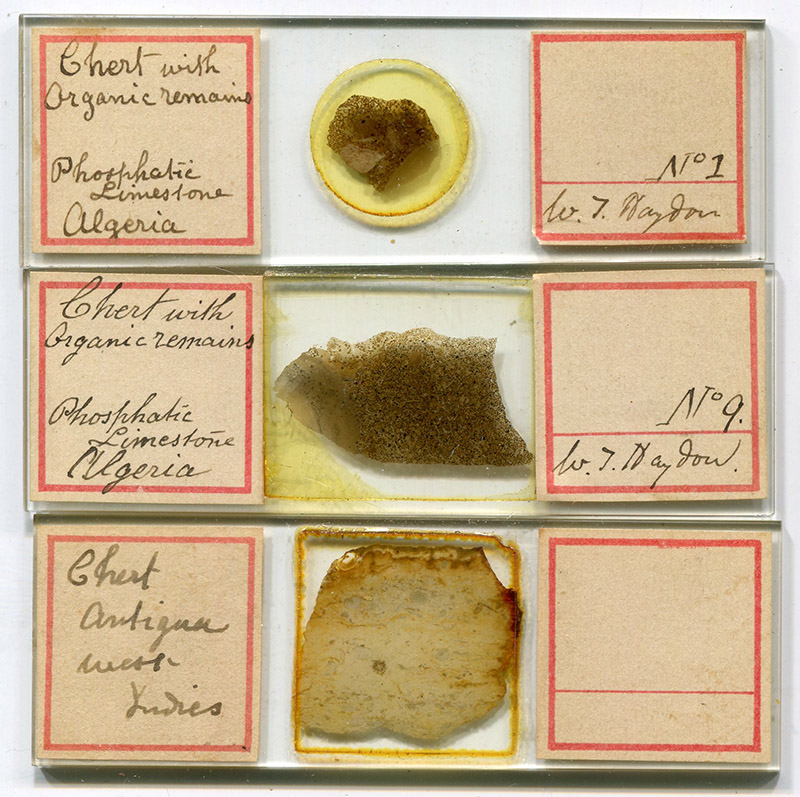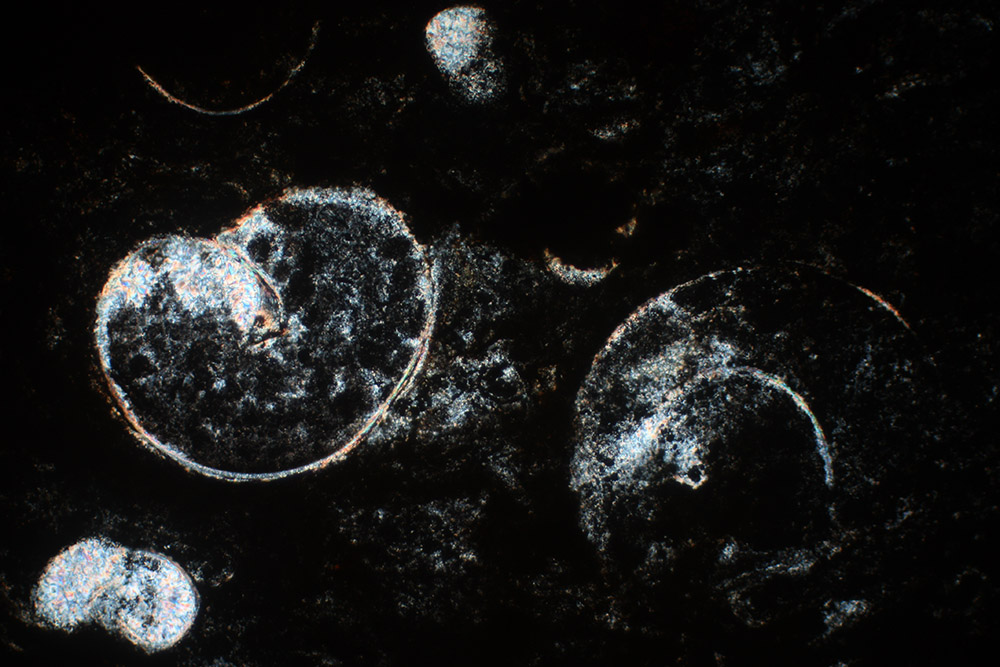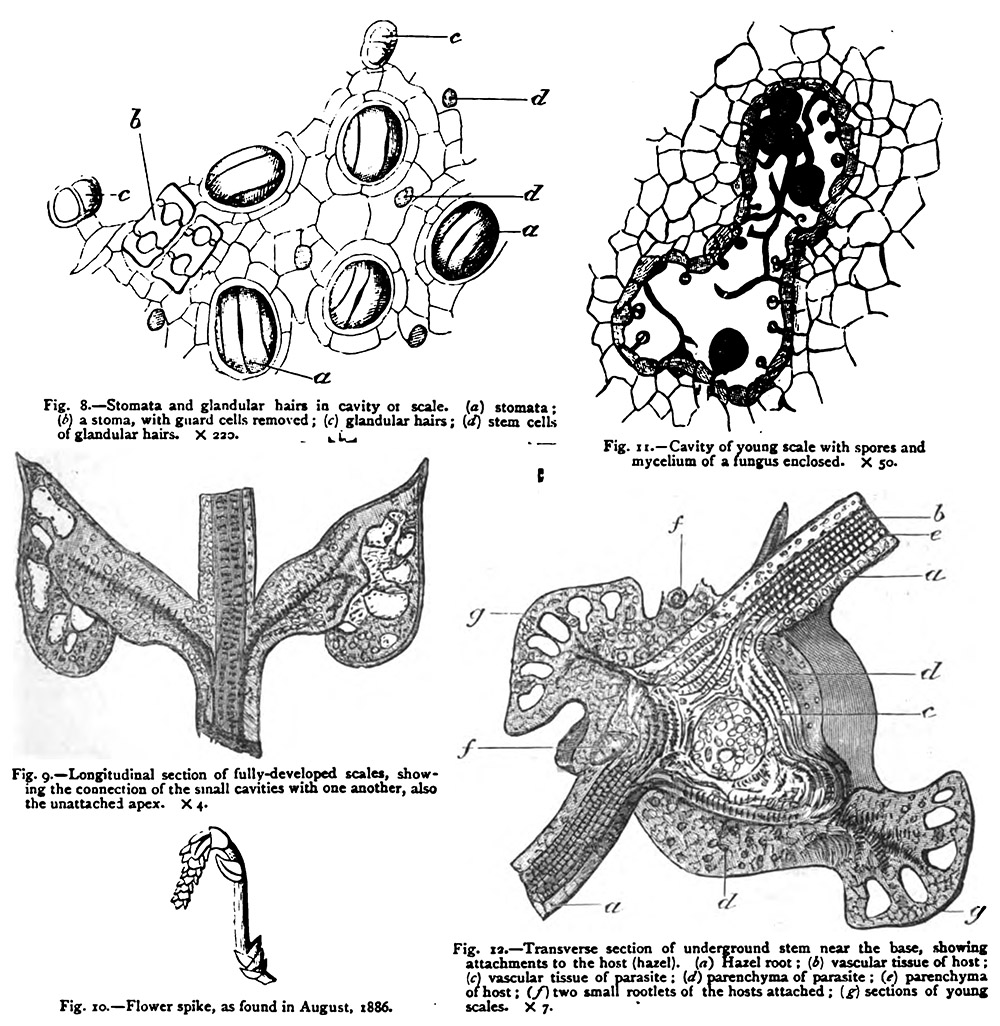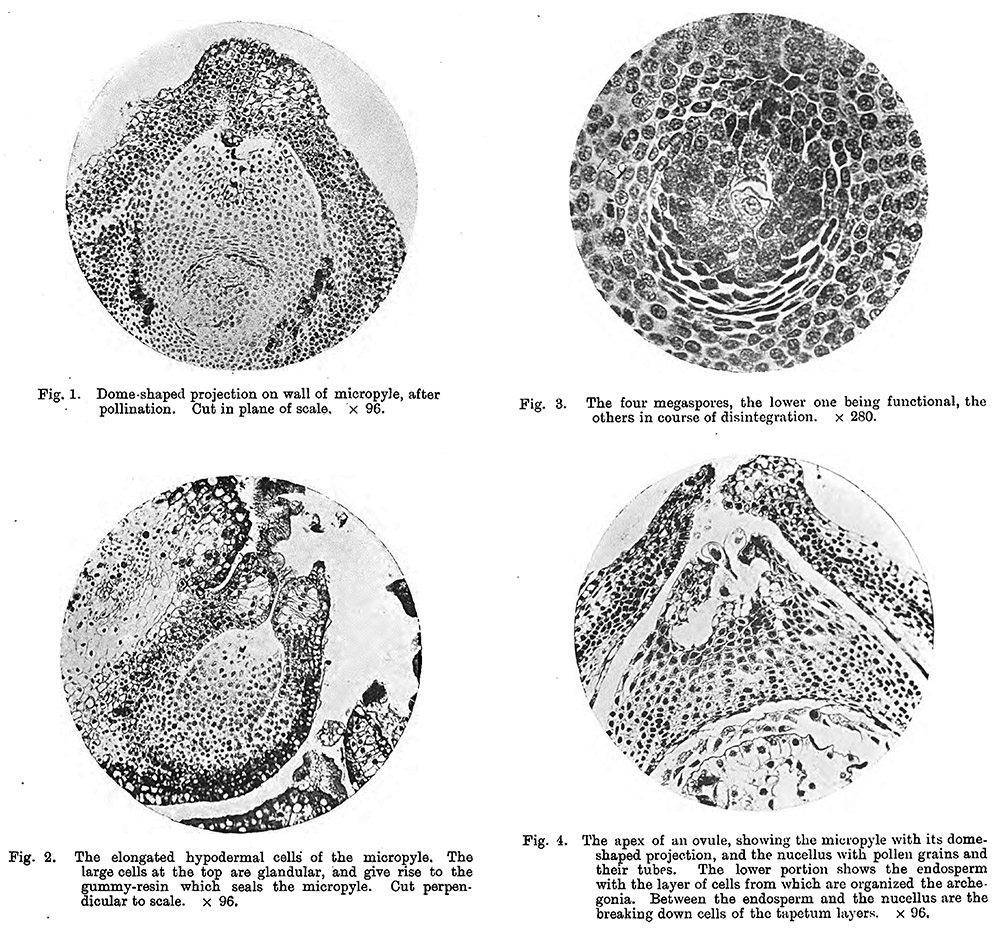Walter Thomas Haydon, 1850 - 1924
by Brian Stevenson
last updated May, 2025
W.T. Haydon was an accomplished amateur scientist and microscopist who studied a wide variety of subjects. He was a Fellow of the Linnean Society and a member of the Liverpool Microscopical Society, the Liverpool Geological Society, the Liverpool Biological Society, the Liverpool Botanical Society, and the Liverpool Science Students’ Association. Haydon prepared a number of fine quality slides of mineral thin-sections, on which he applied handwritten labels and, occasionally, his signature (Figure 1). Considering his longstanding interest in botany, it is likely that Haydon also prepared permanent slides of plant specimens, although I am not aware of any such slides. Perhaps a reader may know of examples?

Figure 1.
Thin-section mounts of chert from Algeria and Antigua, prepared by Walter T. Haydon. The top two slides bear his signature, while lower example is identifiable by the handwriting. Haydon was especially interested in cherts, to the extent that his 1900 Inaugural Address as President of the Liverpool Microscopical Society was on, “A fresh-water chert from Asia Minor, with observations on its formation and structure, together with some account of the organic remains found therein”.

Figure 2.
Shell inclusions in chert from Antigua, West Indies, prepared by W.T. Haydon (see Figure 1). Imaged with a 3.4x objective lens, C-mounted digital SLR camera, and crossed polarizing filters on a Leitz Ortholux II microscope.

Figure 3.
Chert from Algeria, prepared by W.T. Haydon (see Figure 1). Imaged with a 3.4x objective lens, C-mounted digital SLR camera, and crossed polarizing filters on a Leitz Ortholux II microscope.

Figure 4.
Walter Thomas Haydon. Adapted for nonprofit, educational purposes from https://www.livbotsoc.org/history.html . This photograph also appeared in the “Proceedings of the Liverpool Botanical Society”, 1911.
Walter Thomas Haydon was born on October 13, 1850 in Thames Ditton, Surrey, near London. His parents, Walter and Jane (née Brown) Haydon, had married in January of that year. Father Walter worked as a butcher. He died shortly after the marriage, when only 23-24 years old. Mother Jane died in November of 1853, at the age of 28. Their early deaths suggest infectious disease, possibly tuberculosis. As a result, our future microscopist was raised by his maternal grandparents, Daniel and Sarah Brown, who owned the Dog & Bull Public House in Croydon, along with other properties.
Haydon married Ann Newton on December 27, 1871, in Greenwich, Kent. Around the same time, Walter and Anne moved to Colombo, Ceylon. Walter later worked in England as an engineer in factories that processed oil from seeds, suggesting that he performed similar work in Ceylon. Their first two children were born there, Annie ca. 1873 and Jane ca. 1874. The family was back in England by 1876, when the third child, Sarah, was born in Greenwich, Kent.
The 1881 national census listed the family in Dover, Kent, living in “Oil Mill House”. Walter was employed as the “general foreman at oil mill”.
In 1883, Haydon and William Bushell were awarded a patent for “expressing oil from seed and manufacture of oil cakes therefrom.” They received another patent, in 1889, for “improvements in or connected with apparatus or machinery for moulding and pressing seeds and other substances or products.”
By that time, Haydon had become interested in botany and other areas of science. He published an article on the toothwort (Lathraea squamaria) in Hardwicke’s Science-Gossip in 1884, describing the plant’s physiology and parasitic nature. It was accompanied by engraved figures that were based on photographs by Haydon. He also sent a specimen of the plant to the magazine’s editors. Haydon published a follow-up paper on the same plant in 1888, which included pictures drawn by him (Figure 5).
In 1889, he shared microscope slides of toothwort and other parasitic plants with the editors of Hardwicke’s Science-Gossip, who wrote, “W.T. Haydon (Dover) – Accept our best thanks for your slides of sections of union of toothwort with hazel root, orobanche with galium, dodder, etc. They are capital illustrations of parasitism.”
Haydon published a 35-page booklet in 1890, Catalogue of the Flowering Plants, etc., Found in Dover and its Neighbourhood.
He made two contributions to the first issue of The South Eastern Naturalist in 1890: "Leaf fungi of 1889 in the neighbourhood of Dover" and "A Neolithic find near Dover."
The Haydon family moved to the Liverpool area during the 1890s. The 1901 census recorded them living in Toxteth Park, Lancashire, with Walter employed as “works manager, oil seed crushing mills”. The 1921 census listed him as “superintendent engineer” for British Oil & Cake Mills. Presumably in relation to his work, Haydon traveled to the USA and Canada at least twice. However, during one of those trips, he visited places in Massachusetts that are associated with Henry David Thoreau, and those experiences and photographs formed the basis of Haydon's 1912 Presidential Address to the Liverpool Botanical Society.
He joined several Liverpool area scientific societies, and frequently presented exhibits to his colleagues. Of particular note to our topic, Haydon spoke on “The mounting of objects for the microscope” to the Liverpool Science Students’ Association in 1905. He served as President of the Liverpool Microscopical Society in 1900, President of the Liverpool Science Students’ Association in 1907, President of the Liverpool Biological Society in 1908, and President of the Liverpool Botanical Society in 1911 and 1912. Haydon’s Inaugural Address to the Biological Society on pine seeds was illustrated by his own photographs (Figure 6).
Walter Haydon died on May 7, 1924, at his home in Liverpool.

Figure 5.
Illustrations by W.T. Haydon, for his 1888 paper, “Further notes on the toothwort (Lathraea squamaria)”.

Figure 6.
Figures from photographs by W.T. Haydon that illustrated his 1908 Inaugural Address as President of the Liverpool Biological Society.
Resources
Address List of the Linnean Society of London (1911) “1908. Mar. 19. Haydon, Walter Thomas. 55 Grey-road, Walton, Liverpool”, page 20
Annual Report of the Commissioner of Patents (1883) “Bushnell, William, and W.T. Haydon”, Government Printing Office, Washington, page 48
Baptism record of Walter Thomas Haydon (1850) Parish records of St. Nicholas Thames Ditton, accessed through ancestry.com
England census and other records, accessed through ancestry.com
Haydon, W.T. (1884) Notes on the tooth-wort (Lathraea squamaria), Hardwicke’s Science-Gossip, pages 4-5
Haydon, W.T. (1888) Further notes on the toothwort (Lathraea squamaria), Hardwicke’s Science-Gossip, pages 10-14
Haydon, W.T. (1890) Catalogue of the flowering plants, etc., found in Dover and its neighbourhood
Haydon, W.T. (1908) Inaugural Address on the seed production of Pinus sylvestris, Proceedings and Transactions of the Liverpool Biological Society, Vol. 22, pages 3-32
Haydon, W.T. (1912) Henry David Thoreau: poet-naturalist, Proceedings of The Liverpool Botanical Society, pages 55-85
Hardwicke’s Science-Gossip (1884) “W.T. Haydon – accept our best thanks for the specimen of Lathraea squamaria, which fully bears out your opinion”, page 143
Hardwicke’s Science-Gossip (1889) “W.T. Haydon (Dover) – Accept our best thanks for your slides of sections of union of toothwort with hazel root, orobanche with galium, dodder, etc. They are capital illustrations of parasitism”, page 263
Hardwicke’s Science-Gossip (1891) Notes on “South Eastern Naturalist", page 43
The Illustrated Official Journal (Patents) (1889) “William Bushell and Walter Thomas Haydon”, page 319
Marriage record of Walter Haydon and Jane Brown (1850) Parish records of St. Mary Newington, accessed through ancestry.com
Marriage record of Walter T. Haydon and Ann Newton (1871) Parish records of St. Alfege Greenwich, accessed through ancestry.com
The Naturalists’ Directory (1914) “Haydon, W.T., F.L.S., 55 Grey Road, Walton, England”, page 149
Nature (1900) “A freshwater chert from Asia Minor is the text of Mr. W.T. Haydon's presidential address to the Liverpool Microscopical Society, published in the thirty-first annual report of the society. The investigation was based on the examination of some ‘worked flints’ from Hermanjik imported in cargoes of horse beans, which flints were doubtless used as teeth in threshing boards. Thin sections of the flints were remarkably rich in organic remains, chiefly vegetable, including mosses, hepaticæ, pine pollen grains, ferns and grasses; while remains of mollusca, diptera, spiders, &c., were also found. In endeavouring to explain the origin of the silica forming this deposit, an examination was made of some chalk-rock from the same neighbourhood, and this was found to contain great numbers of unmistakable remains of diatoms, but all traces of these disappeared in hydrochloric acid. Mr. Haydon's conclusion is that the flint deposits derived their silica from the diatoms, and that the forms of the latter, as represented in the calcareous rocks, were ‘pseudomorphs’ whose silica was replaced by calcite”, page 520
Probate of the will of W.T. Haydon (1924) “Haydon Walter Thomas of 55 Grey-road Walton Liverpool died 7 May 1924 Probate Liverpool 4 July to Walter Haydon publicity agent and James Richard Haydon mill manager. Effects £4100 5s 11d”, accessed through ancestry.com
Proceedings of the Liverpool Botanical Society (1911) Frontispiece
Proceedings of The Liverpool Botanical Society (1922) Arthur Horatio Dudley (1857-1921), pages 29-30
Proceedings of the Linnean Society of London (1924) “The General Secretary reported that since the last Anniversary the following had died or their deaths been ascertained, namely: … Walter Thomas Haydon”, page 30
Robinson, James F. (1884) Lathraea squamaria, Hardwicke’s Science-Gossip, page 44
Science-Gossip (1900) “Liverpool Microscopical Society. We have received the thirty-first annual report of the Liverpool Microscopical Society, which is an interesting record of the Society's work during the past year. Seven papers, including the President's Inaugural Address, have been read before the Society, each paper being illustrated with the lantern, and at each meeting various objects were exhibited by the members. Two field meetings were held during the summer, which were well attended. The President's (Mr. W.T. Haydon's) address is printed in the report in full, the subject being ‘A fresh-water chert from Asia Minor, with observations on its formation and structure, together with some account of the organic remains found therein’. This is an interesting paper, and suggests many equally interesting directions in which to carry out further investigation. The cherts referred to were ‘Worked Flint’ found in a cargo of horse-beans from Smyrna. Acknowledged ‘experts’ at first pronounced these to be arrow-heads and scrapers, probably of the Neolithic Age; and there are underlying ironies attaching to the subsequent determination that they were really teeth dropped from the old-fashioned threshing-boards still used in Asia Minor to remove the beans from their pods. These cherts were readily traced to their original source, and the paper above alluded to deals with their chemical analysis, and more especially the painstaking microscopical examination by Mr. Haydon and his friends of the abundant vegetable and animal remains found therein. For this, and for the conclusions drawn by the writer as to their process of formation, we must refer our readers to the original paper, the ultimate conclusion being that their origin is mainly diatomaceous”, page 374
The Year-book of the Scientific and Learned Societies of Great Britain and Ireland (1904) Liverpool Microscopical Society … Hon. Secretary: W.T. Haydon, page 136
The Year-book of the Scientific and Learned Societies of Great Britain and Ireland (1905) Liverpool Science Students’ Association, pages 40-41
The Year-book of the Scientific and Learned Societies of Great Britain and Ireland (1908) Liverpool Biological Society … President: W.T. Haydon, page 155
The Year-book of the Scientific and Learned Societies of Great Britain and Ireland (1908) Liverpool Microscopical Society … Hon. Secretary: W.T. Haydon, page 155
The Year-book of the Scientific and Learned Societies of Great Britain and Ireland (1911) Liverpool Botanical Society … President: W.T. Haydon, F.L.S., page 165





